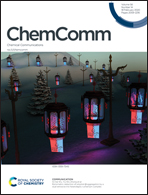Effect of disulphide loop length on mechanochemical structural stability of macromolecules†
Abstract
In Nature, numerous proteins have evolved to perform similar roles, such as mechanical energy dispersion in different tissues. These biological macromolecules obtain their function from their tertiary structure, but proteins with similar roles can be quite different from each other, making it hard to define what structural features could be mimicked in synthetic materials in order to improve their performance. Here, we introduce an important protein feature – disulphide loops – into synthetic polymers and study the role of the loop size on mechanical energy dispersion. By stressing these polymers in solution, we were able to show, experimentally, that the loop size, up to a certain level, has a significant effect on the chain mechanochemical fragmentation rate, indicating it is affecting the polymer unfolding in solution prior to mechanochemical scission of the polymer backbone. Importantly, this experimental study uses homopolymers, providing information on an individual parameter – loop size – which cannot be obtained from comparing different proteins. This research emphasises the use of tailor-designed polymer-peptide hybrids to study fundamental questions on protein tertiary structures.



 Please wait while we load your content...
Please wait while we load your content...